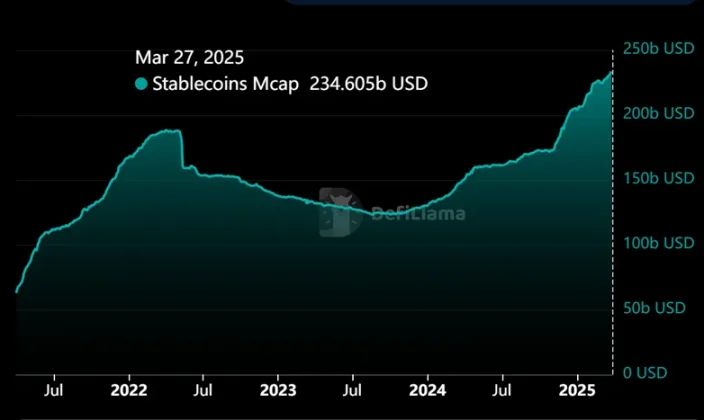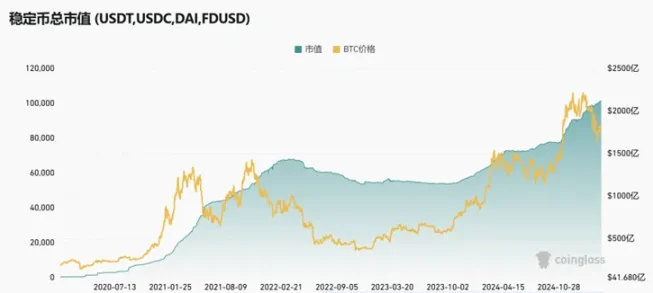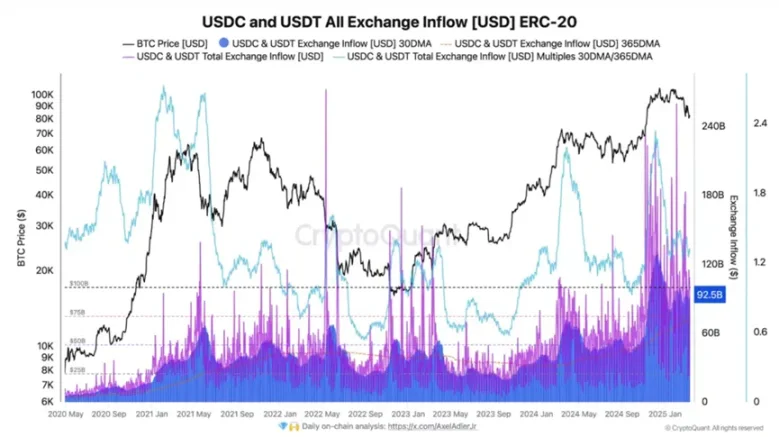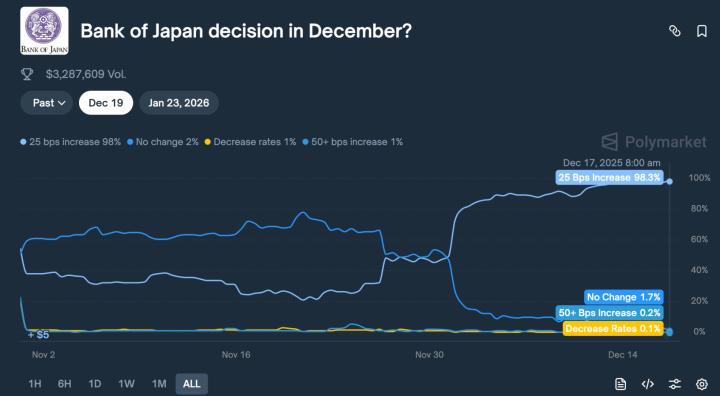According to defillama's data statistics, the stablecoin market value reached a new historical high last week, with a total market value exceeding $234.6 billion, almost doubling from the low point of $124 billion in August 2023. Currently, USDT still leads the stablecoin market with a market share of over 62%.

Meanwhile, the total Crypto market value has experienced a similar trend over the past 2 years, doubling from about $2 trillion in mid-2023 to about $4 trillion, with the peak in December last year. Currently, it has fallen back to around $2.8 trillion, a decline of about 30%, diverging from the stablecoin market value growth.

A fascinating question emerges: Why is the stablecoin market value continuing to grow while the total Crypto market value keeps declining?
The chart of stablecoin total market value and BTC market value shows that before December last year, their trend changes were almost identical. BTC's rise was often accompanied by an increase in stablecoin market value, and BTC's decline would also drive changes in stablecoin market value, though with different volatility.

Statistics show that during the bull market of 2020-2021, USDT issuance was strongly positively correlated with BTC price, with a correlation coefficient exceeding 0.85, confirming this trend change.
The current trend seems to align with the stablecoin and BTC trend in early 2022, when stablecoin market value expanded while BTC retreated. However, the author believes this stablecoin change might differ from that time.
First, regarding the reasons for the separation between stablecoins and BTC price changes, the new funds in this cycle have not directly flowed extensively into the BTC spot market. Data shows that derivative open interest in March 2025 remains high at $54 billion, while exchange spot stablecoin net inflow is relatively weak. This means a large amount of stablecoins are used for leveraged trading (such as futures, perpetual contracts) rather than actual holding demand, and have even become a hedging method.
Secondly, compared to a few years ago when stablecoin usage was mainly concentrated in the Crypto market, stablecoins have now expanded beyond the Crypto industry and started to "move from virtual to real".
According to Visa's survey, in emerging markets, about 47% of users use stablecoins for USD savings, 43% for better currency exchange, and nearly 40% use stablecoins for actual payments (goods, cross-border remittances, or salary payments). In countries like Turkey and Egypt with inflation rates over 50%, the number of stablecoin holders has grown 400% year-on-year, becoming the core asset preservation choice.
Electronic payment giants like PayPal have integrated their stablecoin PYUSD with over 1 million merchants including eBay and Shopify, with transaction volume exceeding $1.2 billion in the first quarter of 2025. BlackRock predicts the stablecoin market will reach $2.8 trillion by 2028, penetrating 5% of global cross-border payments and 15% of the gig economy.
Therefore, the current expansion of the stablecoin market is not limited to Crypto market value growth but also involves the expansion of its application scale. The previous correlation has begun to weaken digitally. So, from the current market, what data should we focus on regarding stablecoins?
The author believes we should focus more on stablecoin inflow data to major exchanges. Historically, a surge in stablecoin inflow coincides with regional tops or bottoms, usually signaling increased volatility. The recent surge exceeded $92.5 billion, one of the highest inflow levels in history.

Although the Crypto market has experienced significant volatility, the market's ups and downs are bringing more changes, driving the industry forward, though not 100% consistent with price changes.
As reported in a recent interesting news story, the Financial Times cited sources that asset management giant Fidelity Investments is advancing the issuance of its own stablecoin, currently in the late testing stage, showing more traditional financial giants joining the stablecoin race.
We must acknowledge that stablecoins are currently the largest application in the Crypto market or blockchain, but the value changes and carrying capacity of this underlying application may quietly change something, as it is also a kind of Web3 user expansion, just not yet bringing a true qualitative change.
As for whether the Crypto market will ultimately benefit from the expansion of stablecoin market value, there's an old saying: Since you're already here, might as well make yourself at home? Like geese leaving their sound and wind leaving its trace, something will always be plucked.








